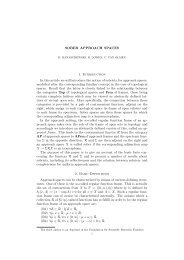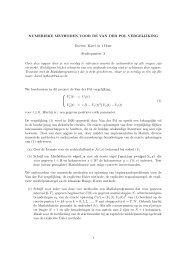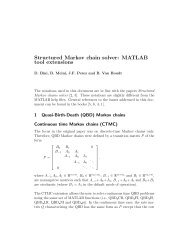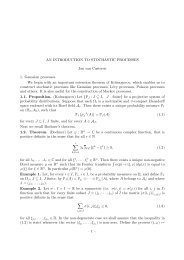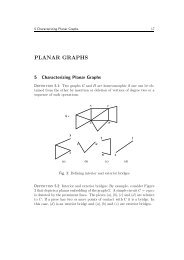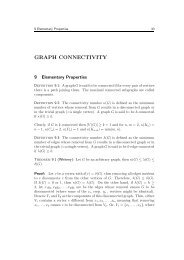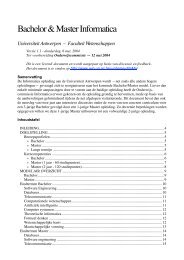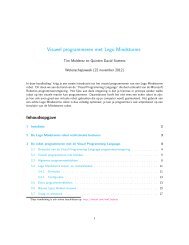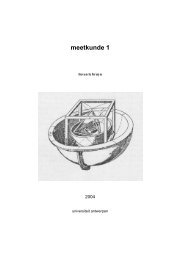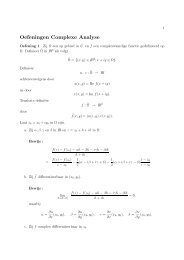Slim: Directly Mining Descriptive Patterns - Universiteit Antwerpen
Slim: Directly Mining Descriptive Patterns - Universiteit Antwerpen
Slim: Directly Mining Descriptive Patterns - Universiteit Antwerpen
You also want an ePaper? Increase the reach of your titles
YUMPU automatically turns print PDFs into web optimized ePapers that Google loves.
1) with high usage (i.e. short codes), 2) replacing manycodes in C, while 3) not adding much complexity. Thefirst two of these properties are simply approximated byfinding frequent itemsets in C.However, we can say more on what itemsets wewant: highly frequent sets of only few items. Besidesthat these sets will likely compress well, they add littlecomplexity to CT . However, keeping in mind that byiteratively refining, if we consider too large itemsets in C,we strongly reduce our search space and are more likelyto end up in a local minimum. Moreover, calculatingthe gain in compression is most accurate for itemsetsof length 2. Hence, we restrict the cardinality of theitemsets we find in C to length 2. Note however, thatmore specific code table elements, i.e. large itemsets inD, can (and are) be constructed in only few iterations.Suppose X and Y are itemsets in CT . Let CT ′be the code table after adding the union of these twoitemsets, i.e. CT ′ = CT ⊕ X ∪ Y . We can estimate theusage of X ∪ Y in CT ′ as|usage(X) ∩ usage(Y )| ,where by usage(X) we slightly abuse notation to referto the tid list of transactions with X in their cover.Note this gives an upper bound to usage(X ∪Y ), whereequality only holds if X ∪ Y is considered for coveringright before when X or Y would be used. As code tableelements are ordered first on length, and the union oftwo non-equal itemsets produces a longer set, this isimplicitly enforced—making the bound quite tight.Although useful, as a gain estimate it is quite rough:it disregards the effects on L(CT | D) of adding X∪Y toCT , the increase of the code lengths of X and Y as theirusage decreases, as well as the scaling effect on all othercode lengths. We can improve our estimate by takingthese effects into account as follows, directly estimatingthe total compressed size for adding a candidate.Let ∆L be the difference in encoded size betweenCT and CT ′ ; or, in other words, the gain in bits forcandidate X ∪ Y . It is easy to see that ∆L for the totalencoded size consists of the difference in compressedsizes of the database, and the difference between theencoded sizes of the code tables,∆L(CT ⊕ X ∪ Y, D)= L(CT, D) − L(CT ⊕ X ∪ Y, D)= ∆L(D | CT ⊕ X ∪ Y ) + ∆L(CT ⊕ X ∪ Y | D) .For notational brevity, we use the lower case, x, ofan itemset X ∈ CT to indicate usage(X), i.e. x =usage(X). Then, let s be the sum of usages of CT , i.e.s = ∑ X∈CT x. Similarly, we use x′ and s ′ for CT ′ .Using this notation, we can write the difference in bitsbetween encoding D by either CT or CT ′ as follows,∆L(D | CT ⊕ X ∪ Y ) = s log s − s ′ log s ′ + xy ′ log xy ′− ∑(c log c − c ′ log c ′ ) ,C∈CTc≠c ′and the difference in the model complexity as∆L(CT ⊕ X ∪ Y | D) = log xy ′ − L(X ∪ Y | ST )+ |CT | log s − |CT ′ | log s ′ + ∑log c ′ − log c+ ∑C∈CTc ′ ≠cc=0C∈CTc ′ ≠cc ′ c≠0log c ′ − L(C | ST ) + ∑C∈CTc ′ ≠cc ′ =0L(C | ST ) − log c ,where xy ′ = usage(X ∪Y ) when using CT ′ . This meansthat we can express the gain in bits when adding X ∪ Yto CT only in terms of the usages of code table elementsfor which the usage changes between CT and CT ′ .In practice, however, it is hard to predict howusage(Z) for all Z ∈ CT will develop when a newelement X ∪ Y is inserted into CT . While we know theusages of Z ∈ CT ordered above X ∪ Y remain static, acascading effect may occur for those below it: in somet ∈ D, where some Z ∈ CT with Z ∩ (X ∪ Y ) ≠ ∅ waspreviously part of the cover of t, X ∪Y may now preventZ from being used; hence changing usage of Z, as well asthe usage of those Z ′ now used to cover Z \(X ∪Y ) of t,which in turn can block other previously used elements,etc.—potentially changing all usages.Although unpredictable, in practice the effect isnot often dramatic. Hence, for practical reasons, forestimating the gain we can assume only the usage ofX, Y , and X ∪ Y will change, using our above usageestimate for X ∪ Y . For calculating the estimated gainin total compressed size, we then simply use xy ′ =|usage(X) ∩ usage(Y )|, x ′ = x − xy ′ , y′ = y − xy ′ ands ′ = s−xy ′ . As such, we obtain a very easily calculable,and generally accurate estimate of ∆L for X ∪ Y .4 <strong>Directly</strong> <strong>Mining</strong> <strong>Descriptive</strong> <strong>Patterns</strong>We can now combine the above results, and constructthe <strong>Slim</strong> algorithm for mining heuristic solutions to theMinimal Coding Set Problem directly from data. 1We give the pseudo-code as Algorithm 2. <strong>Slim</strong>starts with the singleton-only code table ST (line 1).Every iteration (2) we consider all pairwise combinationsof X, Y ∈ CT as candidates in Gain Order, i.e.descending on ∆L(CT ⊕ (X ∪ Y ), D). Iteratively, weadd a candidate to CT in Standard Cover Order1 <strong>Slim</strong> is Dutch for smart, whereas Krimp means to shrink.



